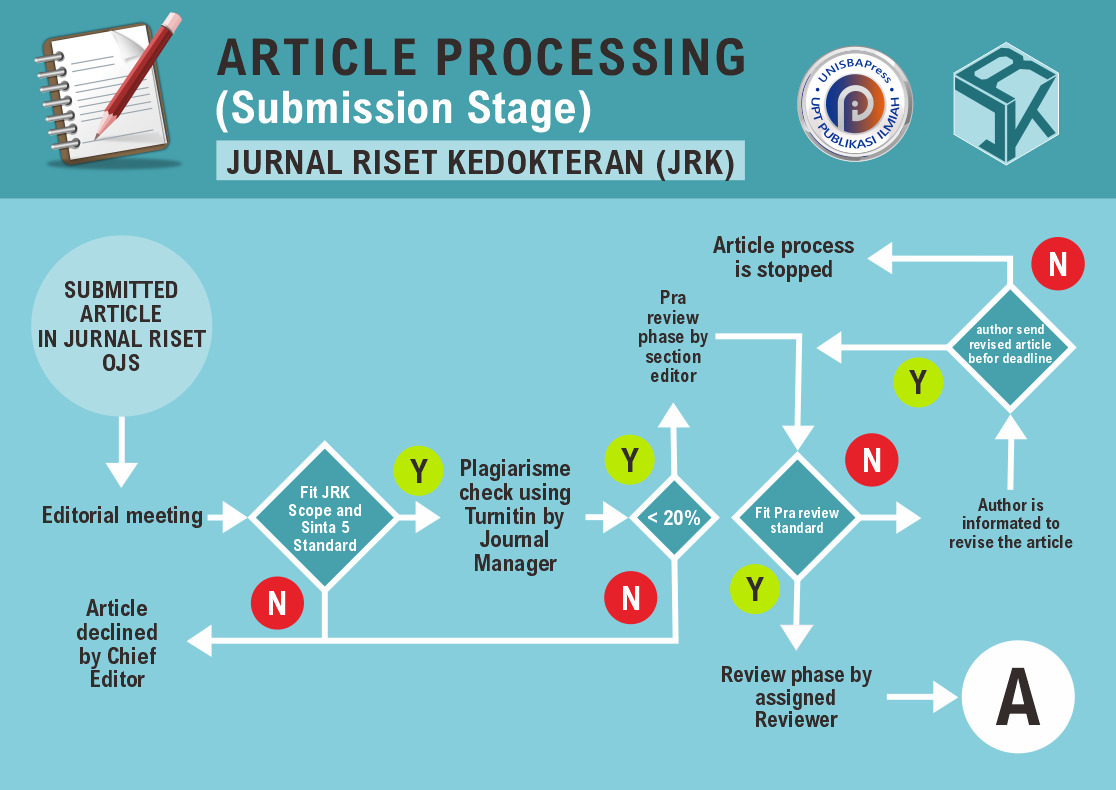Perbedaan Fungsi Paru Antara Siswa yang Merokok dan Tidak Merokok di SMAN 1 Karawang
DOI:
https://doi.org/10.29313/jrk.vi.2299Keywords:
Fungsi paru, KVP, VEP1Abstract
Abstract. Smoking has become a bad habit that is considered normal, especially among teenagers. Harmful substances contained in cigarettes can interfere with lung function. The purpose of this study was to find differences between students who smoke and do not smoke at SMAN 1 Karawang. This research method is analytic observational with cross sectional design. The number of samples in this study amounted to 120 people, consisting of 80% of smoking students and 20% of non-smoking students, who were selected by simple random sampling. Data was taken through a questionnaire based on the Brinkman index and spirometry examination in September 2022. The research data was processed using chi-square with SPSS version 25. The smoking degree classification shows that all smokers are light smokers. The results of the FEV1 score showed that the majority of students had normal lung function (89%), some students with mild obstructive disorder (10%), and only 1 student with moderate degree of obstruction (0.8%). FVC assessment showed that the majority of students had normal lung function (98.3%) and the rest had mild restriction disorders (1.7%). The ratio between FEV1/FVC showed that the majority of students had normal lung function (87.5%), and other students had obstructive disorders (10.8%) and restriction disorders (1.7%). There was no significant difference between smoking habit and lung function (p=0.117). Insignificant results may be influenced by other factors that contribute to lung parenchymal damage.
Abstrak. Merokok sudah menjadi kebiasaan buruk yang dianggap wajar khususnya di kalangan remaja. Zat berbahaya yang terkandung dalam rokok dapat mengganggu fungsi paru. Tujuan penelitian ini yaitu untuk mencari perbedaan antara siswa yang merokok dan tidak merokok di SMAN 1 Karawang. Metode penelitian ini adalah observasional analitik dengan desain cross sectional. Jumlah sampel pada penelitian ini berjumlah 120 orang, terdiri dari 80% siswa yang merokok dan 20% siswa yang tidak merokok, yang dipilih dengan simple random sampling. Data diambil melalui kuesioner berdasarkan indeks Brinkman dan pemeriksaan spirometri pada bulan September 2022. Pengolahan data penelitian dilakukan menggunakan chi-square dengan SPSS versi 25. Klasifikasi derajat merokok menunjukkan seluruh perokok merupakan perokok ringan. Hasil nilai VEP1 menunjukkan mayoritas siswa memiliki fungsi paru normal (89%), beberapa siswa dengan gangguan obstruksi ringan (10%), dan hanya 1 siswa dengan derajat obstruksi sedang (0,8%). Penilaian KVP menunjukkan mayoritas siswa memiliki fungsi paru normal (98,3%) dan sisanya mengalami gangguan restriksi ringan (1,7%). Rasio antara VEP1/KVP menunjukkan mayoritas siswa memiliki fungsi paru normal (87,5%), dan siswa lainnya memiliki gangguan obstruksi (10,8%), dan gangguan restriksi (1,7%). Tidak terdapat perbedaan yang bermakna antara kebiasaan merokok dengan fungsi paru (p=0,117). Hasil yang tidak signifikan dapat dipengaruhi oleh faktor lain yang berkontribusi terhadap kerusakan parenkim paru.
References
Arumsari D, Artanti KD, Martini S, Widati S. the Description of Smoking Degree Based on Brinkman Index in Patients With Lung Cancer. J Berk Epidemiol. 2019;7(3):249.
Bonnie R, Stratton K, Kwan L. Public Health Implications of Raising the Minimum Age of Legal Access to Tobacco Products [Internet]. Washington DC; 2015. Available from: https://www.ncbi.nlm.nih.gov/books/NBK310413/#ref_000324
Sherwood L. Fisiologi Manusia dari Sel ke Sistem. 8th ed. Jakarta; 2014.
Hickin S, Renshaw J, Williams R. Crash Course Respiratory System Basic Science 4th Edition. Vol. 53, Elsevier. 2019. 1689–1699 p.
Suroto S, Jayanti S, Oviera A. Faktor-Faktor Yang Berhubungan Dengan Kapasitas Vital Paru Pada Pekerja Industri Pengolahan Kayu Di Pt. X Jepara. J Kesehat Masy. 2016;4(1):267–76.
Bhutta. KL. Spirometry. 2021; Available from: https://www.ncbi.nlm.nih.gov/books/NBK560526/
Haynes JM. Basic spirometry testing and interpretation for the primary care provider. Can J Respir Ther. 2018;54(4):92–8.
Hickin S, Renshaw J, Williams R. Crash Course Respiratory System Basic Science 4th Edition. Vol. 53, Elsevier. 2019. 1689–1699 p.













